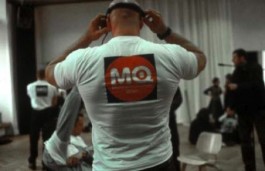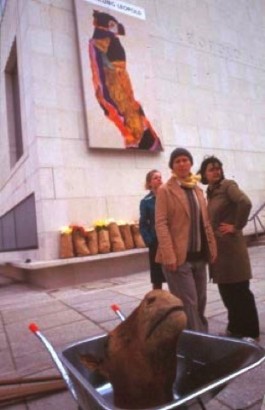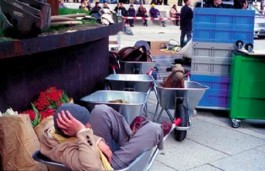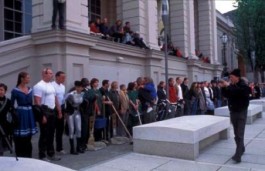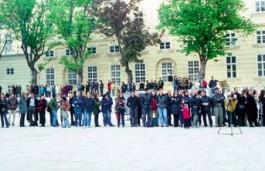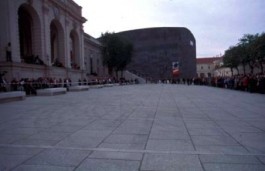“One of the greatest challenges for any contemporary Arts Center is the tension between its civic responsibility to document culturally significant art and artifacts - essentially a conservative role, both archivally and politically - and its essentially progressive mission to indicate and guide the arts audience toward new territory. Given the opportunity to make a site-specific work at this prestigious contemporary Arts Center, I am thinking about the complexity inherent in presenting contemporary art, which, by definition, becomes historicized and cut off from the immediacy of the artistic process once it is housed in a museum. The core of my artistic project has always been my desire to mediate the visual and performative arts, and specifically with this project for the MQ, I have conceived of the possibility of a physical, conceptual and aesthetic infiltration that will engage the public in that complexity. I therefore propose to use the MQ as a matrix where the artistic process in its immediacy and currency, the civic transaction that takes place as art is consumed in public, the collision of the visual and performative potential for artistic creation, and the historical specificity of the MQ will all intersect. This project is an attempt to illuminate the constant tension between the conservation of the past and the artistic urge to innovate.
On April 27th in the afternoon a large truck filled with horse manure will arrive in front of the MQ. A group of 50 performers in uniforms using wheelbarrows will unload the manure and make piles in front or near each entrance of the MQ. They will then methodically spread the manure over the entire public outdoor courtyard. This choreography will be accompanied by contemporary electronic music composed by Viennese musicians either produced live or recorded. Another group of 20 performers, also in uniform, with buckets filled with horse manure will separate and move throughout Vienna on the public transit system for the duration of the piece. The public will be encouraged (through guides, posted signs or broadcasted announcements) to move through the MQ past the atelier spaces along the backside of the Kunsthalle in which there will be a juxtaposing installation. Fresh cut flowers, live performance, recorded classical music (also Viennese, Schoenburg for example) and image projections will fill the long row of ateliers.
Horse manure is the predominant medium in order to create a sensorial experience of multiple effects. By alluding to the historical context of the area as horse stables, it pulls the past life of the architecture into the current cultural significance of the Arts Complex, in effect an olfactory time-shift. That is to say, it serves to create a meeting of past and present frames of reference accompanied by the synesthetic mingling of organic smell, visual stimulation, choreography and cultural memory. The systematic process of carpeting the environment with a substance that is now forbidden within the MQ alchemically transforms it from something marked as “defiling” into an earthwork/art object of beauty and memory which will also be directly reflected by the work installed in the atelier spaces.”
Above is the statement released to all the art organizations within the MuseumsQuartier and the press in Vienna at a press conference staged at the Tanzquartier Wein two weeks before Infiltration. This action along with a very seductive and thorough publicity campaign was successful in attracting a large audience with very specific expectations to the MuseumsQuartier. When the audience arrived what they witnessed was the failure to accomplish the advertised piece. By using 50 “performers” each with different roles such as, “audience member”, “security personnel”, “technician”, “dancer”, “props handler”, etc… I staged the attempt to carry out the intended action but with constant interference and obstacles of regulations, bureaucracy and censorship that were a reflection of what was very real during the process of trying to create Infiltration. What the audience experienced was the excitement of fueled expectations, the frustration of watching everything go wrong, the anger towards the artist and/or the MuseumsQuartier for ruining the event and then the surprising realization that what they were looking at was actually the work. After 30 minutes of choreographed effort, confusion, and failure, the entire cast of 50 gathered in a long line in front of the audience (the curtain call) revealing that the performance of the inability to achieve the advertised Infiltration was the performance itself.
